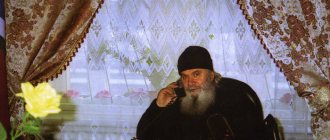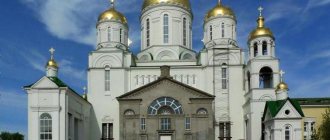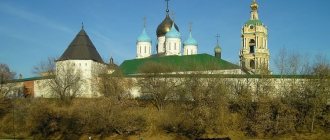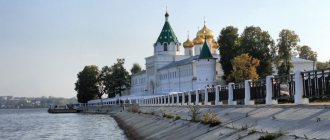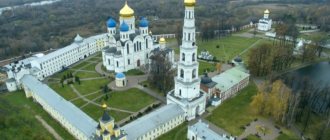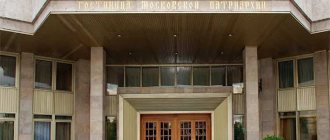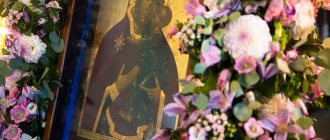Address: Privolzhskaya Sloboda
Opening hours: from 7.00 to 18.30
The most famous and ancient monastery in Nizhny Novgorod, the Ascension Pechersky monastery, was founded towards the end of the 20s. 14th century
.
Its founder is Dionysius
of Suzdal, a monk who left the Kiev Pechersk Monastery in search of solitude, which he found in a makeshift mountain cave on the Volga limestone bank near Nizhny Novgorod.
- Western "holy" gate
- Gate Church of St. Euthymius of Suzdal (1645)
- Ascension Cathedral (1630-32)
- Bell tower (30s of the 17th century)
- Assumption Church (1649)
- Church of St. Peter and Paul (1738)
- Monastic Necropolis
- Museum of the History of the Nizhny Novgorod Diocese
By 1330
In the place of Dionysius’s first settlement,
the Pechersk Ascension
monastery already existed, of which he became abbot. Subsequently, Dionysius will be the Bishop of Suzdal and Nizhny Novgorod, and by the end of the 80s - already the Metropolitan of Kyiv and all Rus'.
Buildings of the Ascension Pechersky Monastery
Historical events
The Pechersk Ascension Monastery traces its history back to the first half of the 14th century, when the monk Dionysius and several monks came from the Kiev-Pechersk Monastery to these places and dug themselves a cave for living and prayer at some distance from the city on the banks of the Volga River.
The monks had with them a copy of the Mother of God Icon Not Made by Hands, called the Pechersk Icon, since the image was miraculously revealed on the wall of the Assumption Cathedral of the monastery they abandoned. This shrine has attracted numerous pilgrims from the Nizhny Novgorod region and far beyond its borders for hundreds of years.
Gradually, many people wanted to join the ascetic life of Dionysius, who settled nearby, digging new caves. But when the hill could no longer accommodate all the godly monks, higher up the slope on the mountain it was necessary to begin the construction of wooden buildings of the monastery.
And soon the first church was built, consecrated in honor of the Ascension of Christ, which gave the name to the new famous monastery.
All monks adhered to strict communal rules with common property, earning their living by their own labor, including the abbot. The spirit of the monastery fully corresponded to the behest of the founder of monasticism in Rus', the Monk Theodosius, and its abbot set an example of high spiritual life: fasting, hard work, mercy and non-covetousness.
The monastery began to enjoy special veneration not only among monastics, but also among the nobility, boyars, grand dukes and other eminent people who turned to Archimandrite Dionysius for advice and prayers, making generous donations to the monastic treasury.
The saint did not leave the care of the monastery even after his elevation to the post of Bishop of Suzdal and Nizhny Novgorod, and with his participation and blessing, the monk Lavrenty began to create a chronicle, which has survived as one of the oldest documents to the present day.
From the monastery came many saints and ascetics, spiritual students of Dionysius, glorified in the bosom of the Orthodox Church.
Among which stand out:
- Saint Euthymius of Suzdal;
- Macarius of Unzhensky and Zheltovodsky.
Both saints later became the founders of Orthodox monasteries on Russian soil. The monastery also became famous for the monk of strict ascetic life, Pavel the Vysoky, who became a famous philosopher and spiritual writer who took part in the training of the future Saint Euphrosyne of Moscow.
Saint Dionysius, elevated to the rank of Metropolitan of Kyiv and All Rus' 2 years before his death, was buried in one of the caves of his native Kiev-Pechersk monastery in October 1385. His holy incorruptible relics were irretrievably lost in the middle of the 17th century.
Over the next centuries, the monastery grew and strengthened, being subjected to enemy attack and destruction, it was again revived due to wealthy donors and contributions from noble boyars and princes. The monastery was granted permission for duty-free fishing and trade in fish, a charter with monastic immunity from Vasily III, and extensive ownership of lands in the district.
After the capture of Kazan, the Tatar-Mongol raids that brought devastating disasters stopped, and the monastery began to be rebuilt in stone.
The Great Russian Dukes became donors for the construction of magnificent churches:
- Ioann Vasilievich the Terrible;
- Feodor Ioannovich.
But during the period of greatest prosperity of the monastery at the end of the 16th century, all 6 erected stone churches and the bell tower were destroyed by a terrible landslide. Fortunately, no one was hurt; the entire monastic brethren managed to leave the walls of the monastery in advance, taking with them the most valuable icons and church utensils. During this event, the miraculous discovery of the incorruptible relics of schema-monk Joasaph took place.
Here, to commemorate the brethren and venerate the holy relics, a wooden Transfiguration Church was erected, later rebuilt in stone. The monastery had to be revived again in a different place, moving a mile higher along the Volga. All buildings were built of wood, and the first stone Ascension Church began to be built only in 1631.
During the period of secularization reforms of Catherine the Great, the previously prosperous monastery was assigned to class I, class 7. All monastery lands were replaced by allocated meager salaries, and the monastery fell on hard times. All the buildings began to fall into disrepair, and the number of brethren decreased greatly.
This period lasted until the middle of the 19th century, when, through the care of the abbot, a new stage of revival and organization of the monastery began, with an increase in the number of monastics and donations, which made it possible to update and repair all the buildings. By the end of the century, the entire architectural ensemble was completely formed.
Before the revolution, the Pechersky Monastery was one of the richest in the country with a huge number of shrines and a magnificent library. The closure of the monastery during the Soviet hard times led to the looting and desolation of the monastery.
The buildings and land were transferred to the management of the museum, but were actually used for living rooms and household needs, ancient bells and wrought-iron church fencing were sent for melting down, a vegetable storage facility was set up in the basement of the main cathedral, and a cinema was opened in the cell building.
In the 60s of the last century, the unique architectural ensemble received the status of a monument of republican significance, the buildings began to be vacated, and 10 years later restoration work began. At the end of the century, the entire territory and buildings were returned to the monastery, a governor was appointed, churches were consecrated and services were resumed.
Today, on the territory of the monastery there is a museum of the history of the diocese with unique archaeological finds and rare documents on display. Here you can also see ancient authentic church utensils and vestments, various awards, icons, photographs from the life of the monastery.
Creation of a new Pechersk monastery
The arrangement of the monastery in a new place again began with wooden buildings, with donations, and with appeals for help to Tsar Fyodor Ioannovich
. Finally, things moved forward, master builders were sent from Moscow, and help came in the form of forty masons from the Ipatiev Monastery in Kostroma.
The new monastery architectural ensemble, in the form in which it exists today, was formed by the mid-17th century
with the direct participation of the Nizhny Novgorod architect
A. Vozoulin
.
This famous architect is the author of the Cathedral of the Archangel Michael in the Nizhny Novgorod Kremlin, a participant in the construction of the Moscow Terem Palace
and one of the restorers of the Moscow Assumption Church.
Gradually, the territory of the Pechersky Monastery was decorated with the five-domed Ascension Church
with an open gallery, a tented
Bell Tower
,
the Assumption Church,
the gate church of St. Euthymius of Suzdal and cell buildings ending with the Temple of St. Macarius. There were the abbot's chambers and service premises, hospitals and almshouses.
Ascension Cathedral in the 19th century
The buildings of the monastery against the backdrop of picturesque nature have become an architectural decoration of the Nizhny Novgorod region, and their view has been captured for centuries in the famous painting by artist A
.
Savrasov
, which, by the way, is located in
the Nizhny Novgorod Art Museum
. The stone fence with the gateway Church of the Intercession on the eastern side of the monastery appeared much later, only in the second half of the 18th century.
Pechersky Monastery in the painting by P. Savrasov
The monastic existence was so successful that the monastery helped not only the poor, the infirm and the elderly, but also often supplied state military units with food and money during various wars. The monastery partially sponsored the creation of a fleet to Peter the Great and gave several of its bells to be melted down into cannons.
Pechersky Monastery in the 19th century
During the First World War
There were about a hundred refugees on the territory of the monastery, a military hospital for disabled people functioned, and the monastery transferred more than four thousand rubles to the treasury for wartime needs.
After the revolutionary events in 1924
the monastery is closed, but not destroyed.
Its buildings are used very intensively, mainly in the form of civil housing. The Ascension Cathedral was suitable as a carpentry workshop
, and the basements were occupied for
vegetable storage
.
The Archimandrite building became a cinema
with the sonorous name “Collective Farmer”.
The Assumption Church was occupied for the archive
.
By 1971, awareness of the historical and architectural value of this monastery complex began and a restoration workshop
.
On the territory of the Pechersky Monastery
The time of revival began in the Pechersk monastery in 1994
. Today this active monastery, still being restored, is a very pleasant place to visit. A small well-groomed area and ancient temples in a very picturesque place invite us to pleasant, calm contemplation and a leisurely walk, and the ancient wall paintings mentally transport us to the distant 17th century.
Architecture, appearance
The Pechersk Ascension Monastery Ensemble, in its modern form that has survived to this day, was erected in stone in the middle of the 17th century.
This was done by such masters:
- the royal apprentice Antip Konstantinov Vozoulin;
- Fedor Oparin;
- Elder Izosima;
- Kostroma and Balakhna masons.
In addition to the Ascension Church, they built tented churches in honor of:
- Saint Euthymius of Suzdal;
- Dormition of the Mother of God;
- Venerable Macarius in the cell building.
The monastery complex looks picturesque from different sides: both from the river and from the mountain. The center of the architectural composition was the main 5-domed cathedral, consecrated in honor of the Ascension of the Lord. The style of construction is very reminiscent of the Assumption Kremlin Church in Moscow, but is distinguished by a refectory chamber and a vast porch with a hipped bell tower on the north side.
The spacious altar consists of 3 apses. The cathedral rises on a limestone white stone basement, surrounded by a gallery of large bricks. The hipped bell tower is attached to the cathedral on an archaic foundation and has Italian style binary arched windows. The structure itself has a noticeable slope, reminiscent of the Leaning Tower of Pisa. The bell tower has a clock with melodic musical chimes.
Pechersky Ascension Monastery, Nizhny Novgorod - architecture and appearance.
At the same time, a tented stone church dedicated to Euthymius of Suzdal was built above the main Holy Gate of the monastery. It is considered unique, the only building of this type in the country that has survived to this day. The style is reminiscent of the Archangel Kremlin Cathedral in Nizhny Novgorod. The elegant, proportional building is designed in the form of an octagon with a hipped roof.
The cellar building was attached to it from the southern part, and then the restored fortress wall of the fence rises.
The warm Assumption Church was built by the same Nizhny Novgorod architect, but in a slightly different style. Its heated rooms have covered closed vaults, and the outer tented part performs a purely decorative function. On three sides of the quadrangle there are zakomaras, divided by blades into 3 spindles. The windows are decorated with hewn brick frames.
The next tier is built in the form of a low octagon, completed with a hipped dome. Covered galleries connected the temple with the Ascension Cathedral and the treasury building. The Church of the Intercession was built much later over the second gate of the monastery, but burned down at the beginning of the 19th century and was rebuilt 50 years later.
It is combined with the eastern cell 2-story building with a common gable roof, topped with a small dome with a cross. In the middle of the 18th century, the monastery fence with decorative towers was rebuilt in stone. By the end of the next century, the main Holy Gates were rebuilt.
Landslide of 1597 and relocation of the monastery
On June 18, 1597, at three o'clock in the morning, the Ascension Pechersky Monastery was destroyed by a giant landslide. Thanks to the early actions of Archimandrite Tryphon (signs of a landslide appeared a week before the disaster), it was possible to avoid casualties and save church property. The Nizhny Novgorod Chronicler (compiled in Nizhny Novgorod in the 17th century and tells about the early history of the city) describes the collapse as follows:
...And by the grace of God, through the intercession of the Most Holy Theotokos, this mountain passed under the monastery with earth and came out into the Volga River and turned out to be hillocks, and those plows under the monastery were on the Volga River, they became on a dry bank from the water at a long distance; and in the monastery, marked by a landslide from the mountain, the stone church of the Ascension of Christ was destroyed to the ground, only the top remained above the altar, the bell tower crumbled, the warm church of the Most Holy Theotokos (Intercession) was shaken to the side and lowered into the ground, near the altar windows; the holy gates, and in the monastery the cells, kitchens and cellars collapsed and the fence was broken, and on the shore the wooden church of St. Nicholas the Wonderworker was moved from its place, and the porch was broken off, and many courtyards in the settlement were shaken.
Since landslides could still happen again, it was decided to move the monastery upstream one mile. On the old site, in memory of the monastery, the Church of the Transfiguration of the Lord was erected. And many considered that landslide to be a harbinger of misfortune - and so it happened: 1598 marks the beginning of the Time of Troubles.
Interior decoration
Unique fragments of 17th-century painting on the vaults of the central drum of the Ascension Cathedral have survived to this day. All the paintings of the temple have been updated, the icons are decorated with rich frames. A carved 4-tier iconostasis separates the altar from the spacious refectory. In the refectory of the Assumption Church there are 2 altars, a sacristy with a monastery library.
The temple stoves are decorated with skillful tiles. The interior of the temple with cross vaults and formwork above the windows and doors is very spacious. In the basement there was a kitchen and a bakery, which were connected by stairs to the western rooms on the 2nd floor. Later, a church-tomb was built in the lower tier for the burial of the brethren and commemoration of the dead.
Shrines
The Pechersk Monastery has a huge number of revered Orthodox shrines, which pilgrims from all over the country come to pray and worship.
Scroll:
- There are crayfish with more than a hundred particles of the relics of the holy Kiev-Pechersk wonderworkers and saints.
- An ark containing a piece of the relics of the blessed Venerable Matrona is available.
- There is an icon of the healer and great martyr Panteleimon with a piece of holy relics.
- You can venerate a particle of the relics of the righteous Simeon of Vekhotursky.
- In the temple there is a revered icon of the Holy Founder of the monastery, Dionysius of Suzdal.
- The Vladimir-Oransky image of the Mother of God is especially revered.
- There is the Theodore Icon of the Mother of God.
- List from the Kiev-Pechersk miraculous image of the Mother of God with Saints Theodosius and Anthony.
Interesting facts and legends
There is unconfirmed information that the monastery was founded by the Holy Blessed Grand Duke George Vsevolodovich at the beginning of the 13th century. Saint Dionysius, having been elevated to the rank of Patriarch, upon his return from Constantinople, was taken prisoner by the Lithuanian prince, where after a year's imprisonment he died.
The future patriarch and reformer of the Russian Church Nikon labored in the monastery for some time. The Pechersk monastery was captured in its historical form in a painting by the great Russian landscape artist A.K. Savrasova. On the territory of the monastery there is an ancient necropolis with burial places of the monastery inhabitants and archimandrites.
In addition, noble townspeople, princes and boyars of different times found their last refuge here: the Trubetskoys, Priklonskys, Shakhovskys, Governor Runovsky and many others. During the Soviet years, the cemetery was seriously devastated; currently, the graves and tombstones are being restored to the best of their ability.
On the territory of the monastery, an alley was decorated in honor of the 400th anniversary of the Romanov dynasty with busts of most representatives of the royal dynasty, made by the sculptor A.A. Apollonov. It is also planned to create a memorial alley in honor of the Rurikovichs and Patriarchs of the Russian Orthodox Church.
Opening hours and schedule of services
The Pechersk Ascension Monastery is open to visitors every day from 7-30 to 19-30. Divine services in the monastery churches are held daily, they begin with midnight at 7 o’clock.
Operating mode:
- On weekdays, the Divine Liturgy begins at 8 a.m., on Sundays at 9 a.m.
- The evening service begins at 5 p.m.
- On Wednesdays and Fridays every week a prayer service is held for the sick. Starts at 12 noon.
- On Friday at 19:00 after the evening service, you can pray together with the canon of repentance in front of the shrine of the relics of the Bethlehem infants.
- Every Thursday at 12 noon prayers are held for patronage and well-being in the endeavors of St. Macarius.
- Every Saturday after the Divine Liturgy there is a memorial service.
Entrance to the territory and churches of the monastery is free.
Those wishing to visit a permanent or thematic museum exhibition must pay admission:
| Adult ticket | 100 rub. |
| For schoolchildren and students | 100 rub. |
| Preschool children | for free |
| Preferential for pensioners | 50 rub. |
| Excursion service | 500 rub. |
An additional fee for a photo session is 100 rubles. You can also take a group or individual tour of the monastery. The museum is open seven days a week from 9 a.m. to 5 p.m., with a break from 12 p.m. to 12:30 p.m. In the monastery refectory you can refresh yourself with delicious pastries and aromatic tea.
Temples
- Ascension Cathedral
- Euphimievskaya gate church, painted according to the model of the Spaso-Evfimievsky Suzdal Monastery
- Assumption Church at the refectory chamber
- Church in honor of the holy apostles Peter and Paul
- Temple in the name of St. Sergius of Radonezh
- House church in the bishop's building.
Among the attractions of the monastery is the bell tower of the Ascension Cathedral, which has a slope and on which there is a clock with a melodious chime. You will also see the monastery cemetery with ancient tombstones.
The monastery houses the Museum of the History of the Nizhny Novgorod Diocese, where you can view the exhibitions and listen to the guide tell a story about the monastery. The museum is open daily from 10:00 to 18:00, except Mondays.
Currently, the Pechersky Monastery is an architectural monument of Federal significance.
How to get there by car, public transport
Pechersky Ascension Monastery is located on the high bank of the Volga next to the highway within the city. It's easy to walk from the Grebnoy Canal embankment. You can get to the monastery from different areas by public transport, following the following city routes to the Sennaya or Monastery stops.
Namely:
- Buses No. 2, 5, 15, 28, 40, 45, 52, 60, 62, 64 or 90;
- Tram number 2;
- Route taxis No. 14, 24, 40, 45, 46, 57, 74, 78, 83, 97 or 98.
Travel by private car is possible from the city center from the square:
- along Minin Street to the Kazan Congress;
- then turn right and exit onto Bolshaya Pecherskaya Street;
- go straight to the 2nd intersection, where turn left;
- further along the Pechersk Congress to the gates of the monastery;
- or drive through Sloboda Pechery.
You can enter the following coordinates for the navigator: 56.323237, 44.049719. Free parking is available at the monastery bakery.
Where to stay
Pilgrims and tourists visiting the monastery can stay at the nearby guest house “Guest House LE 82”, which is located on Rodionova Street, house 82. The small cozy hotel is surrounded by its own garden, has an outdoor terrace, a barbecue area with the necessary utensils, private security car parking.
Airport transfers can be arranged. Guests are offered family rooms, a hearty continental breakfast is included in the price, and delicious coffee is also served. A comfortable room with all amenities and a view of the city or river can be rented from 1.8 thousand rubles. You can stay in a view apartment near the cable car at the address: Kazanskaya embankment 5.
It is possible to accommodate a family or a group of up to 4 people. It features a spacious bedroom with satellite TV, a private bathroom with free toiletries and toiletries, a modern equipped kitchen with a microwave, a dishwasher and a washing machine.
The cost of an apartment per day is 4 thousand rubles. You can also spend the night in a cozy small hotel “Hotel Fonda”, located near the Pechersky Monastery, on the embankment of the Grebnoy Canal 108, building 1. There is a bar and a restaurant here, with food and drinks delivered to your room, and hearty breakfasts are served in the morning.
There is free parking for guests' cars, a common recreation area with a billiard table, and a private beach. Each modern room is equipped with a private bathroom with shower and toiletries, a modern TV, safe, air conditioning, wardrobe, and a magnificent view of the Volga from the windows. The price of a double room starts from 4 thousand rubles.
In the immediate vicinity of the monastery there is a comfortable Premier hotel with a bar, restaurant, common lounge area and free parking. Guests can enjoy a served continental breakfast in the mornings and room service à la carte. Transfer from the airport can be arranged. The cost of a double standard room with a bathroom will cost from 2.6 thousand rubles.
A visit to the Pechersky Nizhny Novgorod Ascension Monastery allows you to take a break from the bustle of city life and feel peace, and the well-groomed territory of the monastery favorably emphasizes the ancient architectural ensemble of the 17th-19th centuries, which is under state protection as a historical monument.
Ascension Pechersky Monastery on the map
Read other interesting articles about Nizhny Novgorod:
- Sights of Nizhny Novgorod - the best places in the city
- Excursions around Nizhny Novgorod - popular places in the city, where to buy, prices 2019
- Hotels in Nizhny Novgorod. Review of the best hotels and apartments in the city, reviews
- Chkalov Stairs - stunning views of the embankment and the Volga River
- Bolshaya Pokrovskaya - the heart of Nizhny Novgorod, how to get there, what to see, photos
- Nizhny Novgorod Kremlin - historical place, towers, panoramic views
- Rozhdestvenskaya Street - how to get there, what to see, a walk along the street
- Verkhnevolzhskaya embankment - how to get there, our walk
- Nizhnevolzhskaya embankment
Websites I use when traveling
- Looking for cheap air tickets on Aviasales
- Book hotels on Booking
- I choose insurance on Cherehapa
- Order a transfer from the airport to Kiwi Taxi
- I rent a car in any city or airport on MyRentaCar
- Tickets for buses, trains, ferries in Asia on 12Go.Asia
- Looking for excursions from locals on Tripster
- Tours at the best price on Travelata and LevelTravel
- Bank card - Tinkoff Black (cash withdrawal abroad without commission, increased cashback)

